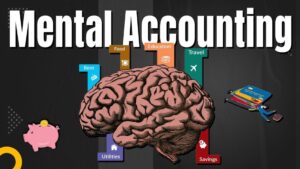A good first impression can last a long time. We often make decisions based on our first thoughts, whether in the first few minutes of a job interview or the first time we look at a stock chart. This influence on our thinking is known in the investment world as “anchoring bias.” Anchors are the pieces of information that we typically look at first when making decisions. This bias can lead people to make poor investment decisions when their initial opinions are incorrect or incomplete. Investors may stick with an original stock price, a compelling headline, or a market forecast even when new information emerges that contradicts their previous beliefs.
As markets change, so does the way we understand them. Anchoring doesn’t do this. There are steps investors can take to avoid anchoring bias. In this article, we’ll discuss how anchoring bias affects investor decisions and how it manifests itself in practice. New and experienced investors need to be aware of this bias so they can make better, more objective decisions in a world of facts and opinions.
How to Understand Anchoring Bias in Finance:
When investors fixate on a single number or piece of data and use it as the standard for all future judgments, this is called anchoring bias. The reference point could be the stock’s initial public offering price, the previous high or low price, or even a price target set by the media or analysts. If a stock originally sold for $100, an investor might consider it “cheap” if it sells for $90, even if future results or forecasts suggest the stock is not worth that much. This reliance on an anchor undermines objective analysis and can lead people to become overconfident or uncertain about what to do, clouding their financial judgment.
How Anchoring Changes the Way We Evaluate Stocks:
The unfortunate thing about anchoring bias is that it changes the way people evaluate stocks. Imagine a company’s stock price drops from $120 to $60 due to poor results in the previous quarter. Investors who hold a $60 stake in a company may consider it a “bargain” simply because it is below $120. They are not looking at the health and prospects of the company. When investors look for apparent value, it is a symptom of more profound problems. This distorted view can lead to incorrect purchasing decisions. The anchoring effect prevents investors from properly assessing current factors because they have to compare them to older data.
Anchoring and Speculating on the Market:
The financial media often speculate on future market movements or give possible price targets. These are pleasing statements, but for individual investors, they are often a given. Predicting that a stock will be worth $150 in six months can change people’s perceptions, even if new information suggests otherwise. Investors sometimes wait a long time for a stock to reach the point they expect. They ignore economic developments, company news, and market changes because they remain fixated on their initial predictions. Such behavior is risky because markets change rapidly and are influenced by many factors that are not initially anticipated.
The concept of anchoring plays a significant role in the phenomenon of loss aversion.
The anchoring effect reinforces loss aversion, making people feel worse when they fail than when they succeed. Someone who buys a home for $75 and the price drops to $50 may not sell it until the price has “recovered” to $75. They still remember the original purchase price, which means they may lose money. They do not have to reevaluate the purchase based on current conditions. This approach can exacerbate losses and delay necessary actions. Instead of limiting losses early and investing money in better opportunities, investors are stuck with an arbitrary number, making it harder to make smart decisions.
Ways to Overcome Anchoring Bias:
To overcome anchoring bias, you first need to be aware of it. Investors must recognize the use of outdated or ineffective data as a benchmark. By focusing on the basics that matter today, such as earnings, cash flow, business trends, and macroeconomic factors, you can ensure that everything continues to run smoothly. Diversification can also help you deal with the emotional impact of becoming emotionally attached to a particular property. In addition, buyers need to get used to making exit and entry plans in advance based on numbers rather than feelings or first impressions. You can remain objective and reduce anchoring bias by regularly evaluating your portfolio and seeking a second opinion from an independent expert.
The Importance of Reframing Financial Decisions:
Reframing is a way of changing your perspective on a problem or choice. In investing, it means looking at each opportunity with a fresh eye, without the bias of past prices or opinions. Instead of asking, “Is this stock cheaper than it used to be?” For example, say, “Based on what I know now, is this stock worth buying today?” This shift in thinking takes practice, but it can lead to better decisions. By moving away from old limiting beliefs, investors can see opportunities more clearly and avoid mistakes that cause them to lose money or miss opportunities.
Why Anchoring Bias Still Exists in the Internet Age:
Despite the abundance of financial tools, data, and educational resources, investors still suffer from anchoring bias. One reason is that there is so much information available that we tend to look at the first number we see. Another reason is that financial news often focuses on short-term changes and predictions. As a result, there are new news trends every day. Additionally, humans are naturally drawn to stability, and anchoring gives us a sense of confidence, even when it’s not real. Resolving this problem requires more than just information. It also requires regular practice and keeping your emotions in check.
Conclusion:
Anchoring bias is a sneaky way to undermine your investment plans. It can subtly alter our perspective, cloud our judgment, and potentially cause us to make big financial mistakes. First impressions are important, but they should not influence your long-term financial decisions. Investors must learn to evaluate their positions regularly, think critically, and be willing to question what they think they know. In a rapidly changing market, clinging to old knowledge is a losing strategy. Investors can improve their clarity, objectivity, and ultimately their investment results by recognizing anchoring bias and taking steps to address it. In the ever-changing financial world, investors who are well-informed and flexible in their thinking are more likely to succeed.
FAQs:
1. What is anchoring bias when it comes to money?
Anchoring bias in investing refers to the tendency to rely too much on the first piece of information you see, such as a stock’s previous price, when making investment decisions, even when you have access to more useful information.
2. How does anchoring bias affect my portfolio?
Sometimes people make bad decisions because they hold on to investments that are losing money for too long or because they think that old or outdated information about a stock’s value indicates what the stock is worth.
3. Do expert investors suffer from anchoring bias?
Anchoring bias can affect even experienced buyers. To limit its effects, it is important to be self-aware and have a rigorous financial strategy.
4. What can I do to avoid anchoring bias in investing?
Use objective data when making your decisions, set clear rules for when to enter and exit your investments, don’t just look at past prices, and reevaluate your investments regularly without relying on them.
5. Is anchoring bias always detrimental?
That’s not always the case, but when it gets in the way of logical thinking, it’s detrimental. You need to stay flexible and make decisions based on the latest, actionable information.




